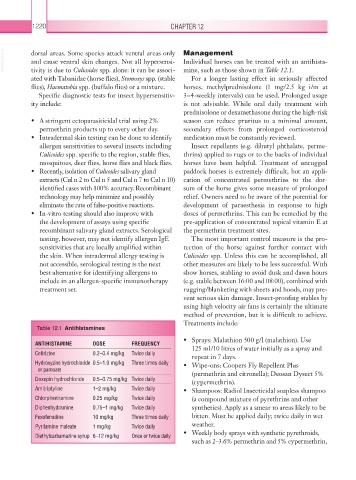Page 1245 - Equine Clinical Medicine, Surgery and Reproduction, 2nd Edition
P. 1245
1220 CHAPTER 12
VetBooks.ir dorsal areas. Some species attack ventral areas only Management
Individual horses can be treated with an antihista-
and cause ventral skin changes. Not all hypersensi-
tivity is due to Culicoides spp. alone: it can be associ-
For a longer lasting effect in seriously affected
ated with Tabanidae (horse flies), Stomoxys spp. (stable mine, such as those shown in Table 12.1.
flies), Haematobia spp. (buffalo flies) or a mixture. horses, methylprednisolone (1 mg/2.5 kg i/m at
Specific diagnostic tests for insect hypersensitiv- 3–4-weekly intervals) can be used. Prolonged usage
ity include: is not advisable. While oral daily treatment with
prednisolone or dexamethasone during the high-risk
• A stringent ectoparasiticidal trial using 2% season can reduce pruritus to a minimal amount,
permethrin products up to every other day. secondary effects from prolonged corticosteroid
• Intradermal skin testing can be done to identify medication must be constantly reviewed.
allergen sensitivities to several insects including Insect repellents (e.g. dibutyl phthalate, perme-
Culicoides spp. specific to the region, stable flies, thrins) applied to rugs or to the backs of individual
mosquitoes, deer flies, horse flies and black flies. horses have been helpful. Treatment of unrugged
• Recently, isolation of Culicoides salivary gland paddock horses is extremely difficult, but an appli-
extracts (Cul n 2 to Cul n 5 and Cul n 7 to Cul n 10) cation of concentrated permethrins to the dor-
identified cases with 100% accuracy. Recombinant sum of the horse gives some measure of prolonged
technology may help minimize and possibly relief. Owners need to be aware of the potential for
eliminate the rate of false-positive reactions. development of paraesthesia in response to high
• In-vitro testing should also improve with doses of permethrins. This can be remedied by the
the development of assays using specific pre-application of concentrated topical vitamin E at
recombinant salivary gland extracts. Serological the permethrin treatment sites.
testing, however, may not identify allergen IgE The most important control measure is the pro-
sensitivities that are locally amplified within tection of the horse against further contact with
the skin. When intradermal allergy testing is Culicoides spp. Unless this can be accomplished, all
not accessible, serological testing is the next other measures are likely to be less successful. With
best alternative for identifying allergens to show horses, stabling to avoid dusk and dawn hours
include in an allergen-specific immunotherapy (e.g. stable between 16:00 and 08:00), combined with
treatment set. rugging/blanketing with sheets and hoods, may pre-
vent serious skin damage. Insect-proofing stables by
using high velocity air fans is certainly the ultimate
method of prevention, but it is difficult to achieve.
Treatments include:
Table 12.1 Antihistamines
• Sprays: Malathion 500 g/l (malathion). Use
ANTIHISTAMINE DOSE FREQUENCY 125 ml/10 litres of water initially as a spray and
Cetirizine 0.2–0.4 mg/kg Twice daily
repeat in 7 days.
Hydroxyzine hydrochloride 0.5–1.0 mg/kg Three times daily • Wipe-ons: Coopers Fly Repellent Plus
or pamoate (permethrin and citronella); Deosan Dysect 5%
Doxepin hydrochloride 0.5–0.75 mg/kg Twice daily (cypermethrin).
Amitriptyline 1–2 mg/kg Twice daily • Shampoos: Radiol Insecticidal soapless shampoo
Chlorpheniramine 0.25 mg/kg Twice daily (a compound mixture of pyrethrins and other
Diphenhydramine 0.75–1 mg/kg Twice daily synthetics). Apply as a smear to areas likely to be
Fexofenadine 10 mg/kg Three times daily bitten. Must be applied daily; twice daily in wet
Pyrilamine maleate 1 mg/kg Twice daily weather.
Diethylcarbamazine syrup 6–12 mg/kg Once or twice daily • Weekly body sprays with synthetic pyrethroids,
such as 2–3.6% permethrin and 5% cypermethrin,

